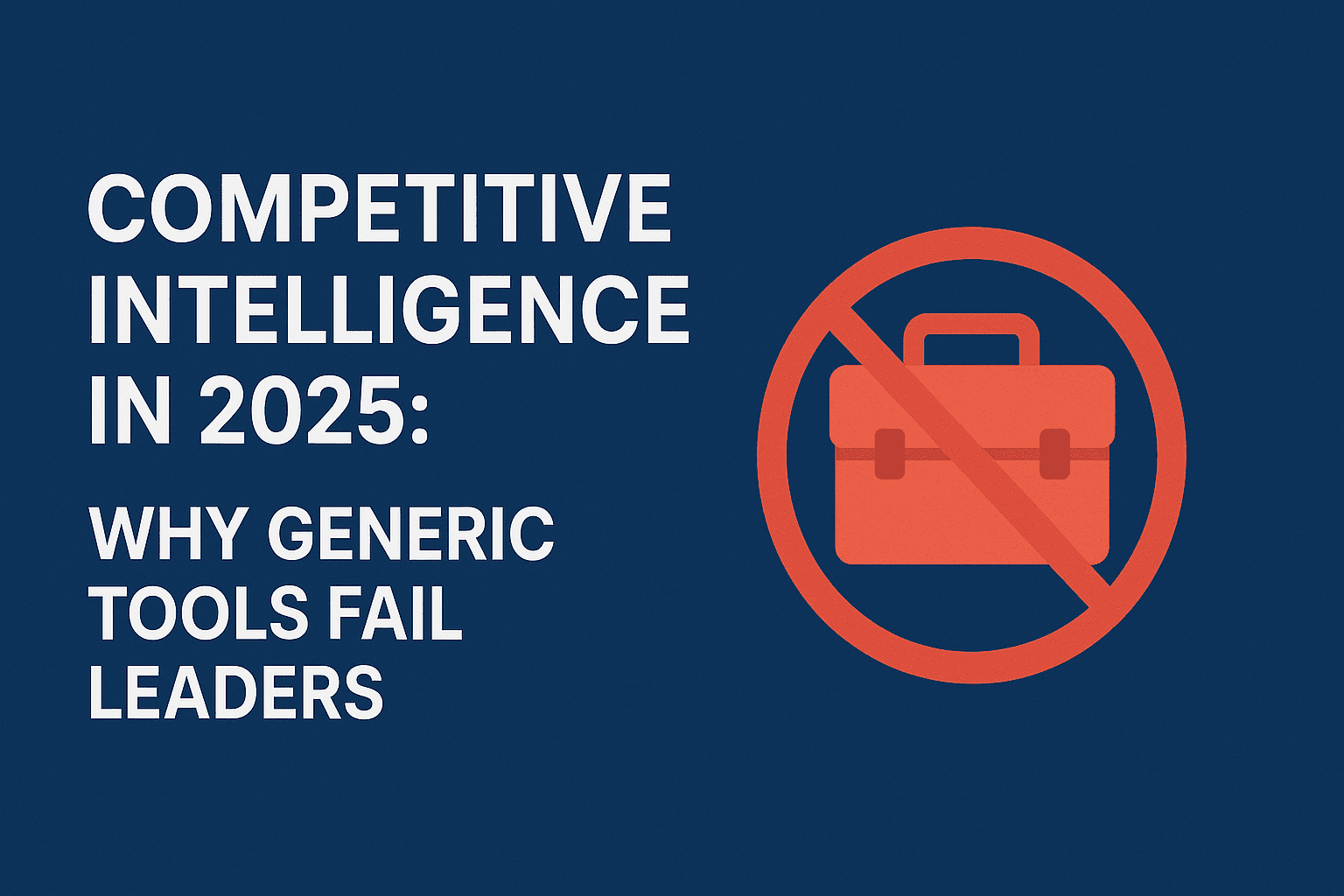Competitive Intelligence in 2025: Why Generic Tools Fail Leaders (And What Actually Works)

The competitive intelligence market is exploding. By 2030, over 85% of businesses will use some form of competitor monitoring—but only 20% will extract strategic value from it. Why? Most tools are built for departments, not decision-makers. Marketing teams get social listening dashboards. Sales reps receive battlecards. Analysts drown in raw data. But for CEOs, founders, and executives, the noise-to-insight ratio remains crippling.
This isn’t just a tool problem—it’s a strategic risk. A 2024 Gartner study found that 63% of leadership teams miss critical competitor moves because they lack context. Meanwhile, startups using AI-driven intelligence tools report 2.3x faster response times to market shifts. The gap is clear: Specialized tools serve teams. Leaders need answers.
Let’s dissect the competitive intelligence ecosystem, expose why most tools fail executives, and reveal how RivalSense is redefining what leaders need in 2025.
The 2025 Competitive Intelligence Toolbox: Who Uses What (And Why It’s Not Enough)
1. Social Listening Platforms: The Marketing Maze
Examples: Brand24, Hootsuite, Sprout Social
Best For: Tracking brand sentiment, campaign engagement, and crisis management.
Leadership Blind Spot: These tools prioritize volume—virality over viability. A startup CEO doesn’t need 500 TikTok mentions of a rival; they need to know if those mentions signal a product flaw or a market trend.
The RivalSense Edge: AI contextualizes social chatter. Example: When a competitor’s “eco-friendly” hashtag surges, RivalSense cross-references patent databases to alert you they’ve filed a green tech trademark—a sign of imminent positioning shifts.
2. SEO & Marketing Suites: Traffic Over Strategy
Examples: Semrush, Ahrefs, Competitors App
Best For: Keyword rankings, backlink audits, and ad spend analysis.
Leadership Blind Spot: Traffic metrics don’t answer strategic questions. A 30% SEO jump for a competitor could mean thought leadership—or desperation to mask declining customer retention.
The RivalSense Edge: We ignore vanity metrics. Instead, we track website changes in pricing pages, executive team bios, or investor relations sections—subtle clues to restructuring, fundraising, or pivots.
3. Sales Intelligence Software: Narrow Focus, Narrow Insights
Examples: Klue, Crayon, Valona
Best For: Real-time battlecards for sales calls.
Leadership Blind Spot: Sales tools focus on “what to say next quarter.” Leaders need “what to build next year.” When a competitor’s sales materials suddenly emphasize “modular pricing,” RivalSense correlates it with their job postings for usage-based billing experts—signaling a pricing model overhaul.
4. Basic Alert Systems: The False Promise of “Free”
Examples: Google Alerts, Talkwalker Alerts
Best For: Casual brand monitoring.
Leadership Blind Spot: These tools miss 72% of critical data (per Forrester), including non-indexed sources like regulatory filings or niche industry forums.
The RivalSense Edge: We monitor hidden channels—e.g., a competitor’s FDA trial update buried in a clinical registry, or a logistics expansion hinted in a local government permit.
5. Market Research Firms: Insight Lag
Examples: AlphaSense, Evalueserve, Contify
Best For: Deep-dive industry reports for enterprises.
Leadership Blind Spot: Human-curated insights take weeks. By then, the data is stale. When a rival biotech firm quietly partners with a CRISPR startup, RivalSense flags it in real-time—not in a quarterly report.
The Leadership Gap: Why Most Tools Leave Executives Stranded
Business leaders face three unmet needs in 2025:
- Speed-to-Insight: Departmental tools require analysts to interpret data. RivalSense uses AI to act as your analyst.
- Cross-Functional Intelligence: Marketing tools ignore regulatory risks. Sales tools miss R&D signals. RivalSense connects disparate data points into a single narrative.
- Decision-Ready Alerts: Leaders don’t need more dashboards—they need annotated, board-meeting-ready insights.
Case in Point:
When a fintech competitor quietly removed “small business” from their homepage, RivalSense users received this alert:
*“Competitor X has de-emphasized SMBs in messaging (+3 website changes). Correlated with 11 new enterprise-focused job postings and a 22% price hike on SMB plans. Recommendation: Acquire displaced SMB clients via targeted incentives.”*
RivalSense 2025: How AI Closes the Leadership Intelligence Gap
1. Autonomous Source Prioritization
Unlike tools that force you to pick keywords or URLs, RivalSense’s AI:
- Identifies high-impact pages (pricing, careers, investor pages).
- Monitors “unsexy” but critical sources (regulatory filings, court records).
- Ignores trivial changes (blog updates, stock photos).
2. Strategic Pattern Detection
Generic tools report what changed. RivalSense explains why it matters:
- A 10% price drop + a new logistics VP = Expansion into cost-sensitive markets.
- A surge in “remote work” press mentions + a deleted office lease listing = Permanent remote shift.
3. Boardroom-Ready Synthesis
RivalSense’s “Executive Brief” feature auto-generates insights like:
- “Competitor Y’s 4 patent filings in blockchain suggest a Q4 product launch. Adjust your roadmap or risk cannibalization.”
- “Competitor Z’s FDA submission delay (6 months) creates a window to capture 18% of their pipeline.”
The Cost of Inaction
In 2025, leaders who rely on fragmented tools will:
- Miss hidden risks: 42% of competitive threats now emerge from non-traditional sources (e.g., regulatory changes, executive LinkedIn activity).
- Waste time: Executives spend 6.8 hours weekly reconciling conflicting reports from marketing, sales, and finance tools.
- Lag on decisions: AI-driven firms detect competitor pivots 3.2x faster than those using manual tools.
Your Move: Lead or Follow?
RivalSense isn’t another SaaS tool—it’s a leadership advantage. Over 4,200 executives use it to:
- Spot competitor vulnerabilities before they’re obvious.
- Turn data into boardroom narratives.
- Free up 12+ hours monthly wasted on tool juggling.
👉 Claim Your Free Trial Now
No credit card. No setup. Get your first Strategic Brief in 7 minutes.
See Around Corners with RivalSense
Final Insight:
By 2030, competitive intelligence will bifurcate into two categories:
- Departmental Tools (for marketers, sales reps, analysts).
- Leadership Tools (for those who decide the future).
Which will you choose?
